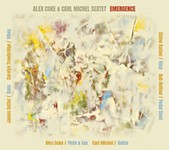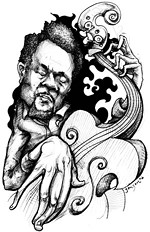Central Avenue Sounds (Rhino)
Box Sets
Reviewed by Harvey Pekar, Fri., Dec. 17, 1999
Central Avenue Sounds
(Rhino)
This 4-CD set aims to document the growth and evolution of African-American music in Los Angeles from 1921-56. Actually, the city had a relatively small black population prior to 1940, so the years 1921-39 are represented by only 15 tracks. Twelve of those could be considered bogus in that they're by artists from New Orleans (Kid Ory, Jelly Roll Morton, Louis Armstrong) or Toledo (Art Tatum), who were passing through L.A. and happened to record there. However, Paul Howard's Quality Serenaders was an L.A.-based band, containing native trombone great Lawrence Brown, who would later star with Duke Ellington. Howard's drummer, who doubled on vibes, Lionel Hampton, grew up in Chicago, but when he formed his big band in 1940, worked out of L.A. During the mid-Thirties, the great blues singer and pioneering electric guitarist T-Bone Walker emigrated from Texas to L.A., and had an important impact on the scene there. He's represented on this set by "T-Bone Blues," which he cut with Les Hite's band (the Hawaiian-style electric guitar solo on it is by Frank Pasley, not T-Bone). Walker is also heard a couple of years later on "Mean Old World," which became one of his most popular pieces. One of Walker's disciples, Pee Wee Crayton, is represented here as well. In the early Forties, when many blacks were moving to L.A. seeking employment opportunities, the ingredients of rhythm and blues music were being blended there. The form drew not only on the electric blues style of Walker, but the sometimes over-the-top tenor sax playing of Illinois Jacquet, heard here with Hampton on the classic "Flyin' Home." Several important early R&B figures, including Earl Bostic and Jimmy Scott, worked with Hampton in the Forties, and by the mid-Forties, R&B was up and running, characterized by earthy vocals, strong electric guitar work, honking, screaming saxophones, boogie woogie style piano work, and battering drumming. Many popular R&B performers got their start in L.A. and are heard here, including Roy Milton, Joe Liggins, Cecil Gant, Charles Brown, and Johnny Otis, who actually was of Greek descent. L.A. was also a center of bebop activity. Bop precursor Lester Young performs on a 1941 airshot, while scattered throughout, there are recordings by out-of-towners Charlie Parker, Wardell Gray, and Howard McGhee. Longtime L.A. residents, including Dexter Gordon, Buddy Collette, and Teddy Edwards, all represented here, were important figures in the bop scene too, though. Beyond this, L.A. was also a center for experimental big band music, which was sometimes classically influenced. Examples of this "progressive jazz" by Charlie Mingus, Gerald Wilson, and a Roy Porter band containing future greats Eric Dolphy, Art Farmer, and Jimmy Knepper, can be heard on the set. In 1956, when this set ends, the L.A. bop and post-bop artists were being eclipsed in popularity by the cool and mostly white West Coast jazzmen, e.g. Gerry Mulligan, Chet Baker, and Dave Brubeck. This was a temporary situation, however, as the bop/post-bop movement turned out to be longer lived. The set concludes rather arbitrarily, apparently because the club scene on L.A.'s once very active Central Avenue had declined in the mid-Fifties. What's important, though, is that the African-American music scene in L.A. remains vibrant.
![]()
![]()
![]()
![]()









